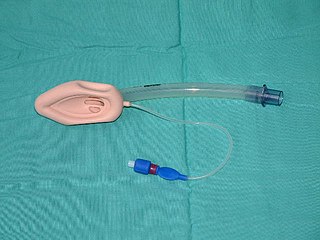General anaesthetics are often defined as compounds that induce a loss of consciousness in humans or loss of righting reflex in animals. Clinical definitions are also extended to include an induced coma that causes lack of awareness to painful stimuli, sufficient to facilitate surgical applications in clinical and veterinary practice. General anaesthetics do not act as analgesics and should also not be confused with sedatives. General anaesthetics are a structurally diverse group of compounds whose mechanisms encompass multiple biological targets involved in the control of neuronal pathways. The precise workings are the subject of some debate and ongoing research.
A convulsion is a medical condition where the body muscles contract and relax rapidly and repeatedly, resulting in uncontrolled shaking. Because epileptic seizures typically include convulsions, the term convulsion is often used as a synonym for seizure. However, not all epileptic seizures result in convulsions, and not all convulsions are caused by epileptic seizures. Non-epileptic convulsions have no relation with epilepsy, and are caused by non-epileptic seizures.

An electrical injury, or electrical shock is damage sustained to the skin or internal organs on direct contact with an electric current.

Electrophorus electricus is the best-known species of electric eel. It is a South American electric fish. Until the discovery of two additional species in 2019, the genus was classified as the monotypic, with this species the only one in the genus. Despite the name, it is not an eel, but rather a knifefish. It is considered as a freshwater teleost which contains an electrogenic tissue that produces electric discharges.

General anaesthesia (UK) or general anesthesia (US) is a method of medically inducing loss of consciousness that renders a patient unarousable even with painful stimuli. This effect is achieved by administering either intravenous or inhalational general anaesthetic medications, which often act in combination with an analgesic and neuromuscular blocking agent. Spontaneous ventilation is often inadequate during the procedure and intervention is often necessary to protect the airway. General anaesthesia is generally performed in an operating theater to allow surgical procedures that would otherwise be intolerably painful for a patient, or in an intensive care unit or emergency department to facilitate endotracheal intubation and mechanical ventilation in critically ill patients.

A laryngeal mask airway (LMA), also known as laryngeal mask, is a medical device that keeps a patient's airway open during anaesthesia or while they are unconscious. It is a type of supraglottic airway device. They are most commonly used by anaesthetists to channel oxygen or inhalational anaesthetic to the lungs during surgery and in the pre-hospital setting for unconscious patients.
Awareness under anesthesia, also referred to as intraoperative awareness or accidental awareness during general anesthesia (AAGA), is a rare complication of general anesthesia where patients regain varying levels of consciousness during their surgical procedures. While anesthesia awareness is possible without resulting in any long-term memory of the experience, it is also possible for victims to have awareness with explicit recall, where they can remember the events related to their surgery.

Functional electrical stimulation (FES) is a technique that uses low-energy electrical pulses to artificially generate body movements in individuals who have been paralyzed due to injury to the central nervous system. More specifically, FES can be used to generate muscle contraction in otherwise paralyzed limbs to produce functions such as grasping, walking, bladder voiding and standing. This technology was originally used to develop neuroprostheses that were implemented to permanently substitute impaired functions in individuals with spinal cord injury (SCI), head injury, stroke and other neurological disorders. In other words, a person would use the device each time he or she wanted to generate a desired function. FES is sometimes also referred to as neuromuscular electrical stimulation (NMES).

Stunning is the process of rendering animals immobile or unconscious, with or without killing the animal, when or immediately prior to slaughtering them for food.

Hervey Milton Cleckley was an American psychiatrist and pioneer in the field of psychopathy. His book, The Mask of Sanity, originally published in 1941 and revised in new editions until the 1980s, provided the most influential clinical description of psychopathy in the twentieth century. The term "mask of sanity" derived from Cleckley's belief that a psychopath can appear normal and even engaging, but that the "mask" conceals a mental disorder. By the time of his death, Cleckley was better remembered for a vivid case study of a female patient, published as a book in 1956 and turned into a movie, The Three Faces of Eve, in 1957. His report of the case (re)popularized in America the controversial diagnosis of multiple personality disorder. The concept of psychopathy continues to be influential through forming parts of the diagnosis of antisocial personality disorder, the Psychopathy Checklist, and public perception.

The Humane Slaughter Act, or the Humane Methods of Livestock Slaughter Act, is a United States federal law designed to decrease suffering of livestock during slaughter. It was approved on August 27, 1958. The most notable of these requirements is the need to have an animal completely sedated and insensible to pain. This is to minimize the suffering to the point where the animal feels nothing at all, instead blacking out and never waking. This differs from animal to animal as size increases and decreases. Larger animals such as bovines require a stronger method than chickens, for example. Bovines require electronarcosis or something equally potent, though electronarcosis remains a standard. The bovine would have a device placed on their head that, once activated, sends an electric charge that efficiently and safely stuns them. Chickens, on the other hand, require much less current to be efficiently sedated and are given a run under electrically charged water. To ensure that these guidelines are met, the Food Safety and Inspection Service inspectors at slaughtering plants are responsible for overseeing compliance, and have the authority to stop slaughter lines and order plant employees to take corrective actions. Although more than 168 million chickens and around 9 billion broiler chickens are killed for food in the United States yearly, the Humane Slaughter Act specifically mentions only cattle, calves, horses, mules, sheep and swine.
Bioelectromagnetics, also known as bioelectromagnetism, is the study of the interaction between electromagnetic fields and biological entities. Areas of study include electromagnetic fields produced by living cells, tissues or organisms, the effects of man-made sources of electromagnetic fields like mobile phones, and the application of electromagnetic radiation toward therapies for the treatment of various conditions.
Entropy monitoring is a method of assessing the effect of certain anaesthetic drugs on the brain's EEG. It was commercially developed by Datex-Ohmeda, which is now part of GE Healthcare.
In Islamic law, dhabīḥah, also spelled zabiha, is the prescribed method of slaughter for halal animals. It consists of a swift, deep incision to the throat with a very sharp knife, cutting the wind pipe, jugular veins and carotid arteries on both sides but leaving the spinal cord intact. The butcher is also required to call upon the name of Allah (Bismillah) individually for each animal.

Animal slaughter is the killing of animals, usually referring to killing domestic livestock. It is estimated that each year, 80 billion land animals are slaughtered for food. Most animals are slaughtered for food; however, they may also be slaughtered for other reasons such as for harvesting of pelts, being diseased and unsuitable for consumption, or being surplus for maintaining a breeding stock. Slaughter typically involves some initial cutting, opening the major body cavities to remove the entrails and offal but usually leaving the carcass in one piece. Such dressing can be done by hunters in the field or in a slaughterhouse. Later, the carcass is usually butchered into smaller cuts.

A generalized tonic–clonic seizure, commonly known as a grand mal seizure or GTCS, is a type of generalized seizure that produces bilateral, convulsive tonic and clonic muscle contractions. Tonic–clonic seizures are the seizure type most commonly associated with epilepsy and seizures in general and the most common seizure associated with metabolic imbalances. It is a misconception that they are the sole type of seizure, as they are the main seizure type in approximately 10% of those with epilepsy.
Electroanalgesia is a form of analgesia, or pain relief, that uses electricity to ease pain. Electrical devices can be internal or external, at the site of pain (local) or delocalized throughout the whole body. It works by interfering with the electric currents of pain signals, inhibiting them from reaching the brain and inducing a response; different from traditional analgesics, such as opiates which mimic natural endorphins and NSAIDs that help relieve inflammation and stop pain at the source. Electroanalgesia has a lower addictive potential and poses less health threats to the general public, but can cause serious health problems, even death, in people with other electrical devices such as pacemakers or internal hearing aids, or with heart problems.

In anesthesia, neuromuscular blocking agents may be required to facilitate endotracheal intubation and provide optimal surgical conditions. When neuromuscular blocking agents are administered, neuromuscular function of the patient must be monitored. Neuromuscular function monitoring is a technique that involves the electrical stimulation of a motor nerve and monitoring the response of the muscle supplied by that nerve. It may be used from the induction of to recovery from neuromuscular blockade. Importantly, it is used to confirm adequacy of recovery after the administration of neuromuscular blocking agents. The response of the muscles to electrical stimulation of the nerves can be recorded subjectively (qualitative) or objectively (quantitatively). Quantitative techniques include electromyography, acceleromyography, kinemyography, phonomygraphy and mechanomyography. Neuromuscular monitoring is recommended when neuromuscular-blocking drugs have been part of the general anesthesia and the doctor wishes to avoid postoperative residual curarization (PORC) in the patient, that is, the residual paralysis of muscles stemming from these drugs.
Fish slaughter is the process of killing fish, typically after harvesting at sea or from fish farms. At least one trillion fish are slaughtered each year for human consumption. Some relatively humane slaughter methods have been developed, including percussive and electric stunning. However, most fish harvesting continues to use methods like suffocation in air, carbon-dioxide stunning, or ice chilling that may not optimise fish welfare in some instances.

Suction Assisted Laryngoscopy Airway Decontamination (SALAD) is incremental step-wise approach to the management of a massively contaminated airway.












